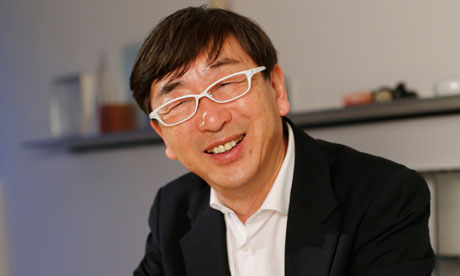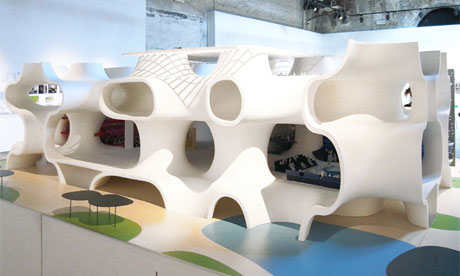Submitted by Berrin Chatzi Chousein
Toyo Ito: the ’dropout robot’ who never tires of reinventing himself
Turkey Architecture News - Mar 21, 2013 - 21:39 10335 views
The 71-year-old architect has finally won the Pritzker prize for an experimental body of work that refuses to be pinned down

'Dropout robot' … Toyo Ito has been awarded the 2013 Pritzker prize, the Nobel prize of the architecture world. Photograph: Koji Sasahara/AP
When it was announced this week that Toyo Ito is to receive the 2013 Pritzker prize, the reaction of many was: "Hasn't he already got it?"
The 71-year-old Japanese architect is long overdue the venerated gong, having built a consistently revolutionary body of work over the last 40 years, and whose office has already spawned a whole new generation of established Japanese architects – including Kazuyo Sejima and Ryue Nishizawa, of Sanaa, who won the Pritzker back in 2010.
"After a Chinese architect won last year and Sanaa three years ago, I did not expect it would be me this time," Ito told the LA Times, sharing others' surprise.
As the sixth architect from Japan to receive the award – following Kenzo Tange in 1987, Fumihiko Maki in 1993, Tadao Ando in 1995, and Sejima and Nishizawa – Ito is perhaps the hardest to pigeonhole. He has no house style, and his projects have veered dramatically between different techniques in a process of constant experimentation.
Treating his office as an open laboratory, his employees are encouraged to pursue their own directions, and each project takes a radically new approach to developing a different kind of structural system, specific to the building, programme and site at hand.
One of his earliest buildings, now demolished and much mourned for by architects, was the White U house in Tokyo, which he built for his sister and her daughters in 1976 after the death of her husband. It was a monolithic, tyrannical house – a contemplative tube of white space wrapped around a solitary courtyard in a U-shape. It turned its back on the world with high windowless walls, the interior spaces lit only by chinks of daylight. One by one, the family left the house, describing living in it as being "imprisoned in a coffin" – an attitude seemingly shared by their pets, who all refused to be alone in the enclosed courtyard.
It is a project that might appear to sit unhappily with the Pritzker jury's citation that Ito's architecture "projects an air of optimism, lightness and joy, and is infused with both a sense of uniqueness and universality".
But a house for a mourning sister is a very different creature to a public library, and Ito designed one of the most transparent, open and uplifting of recent years in the city of Sendai in 2001. The culmination of a decade-long preoccupation with the effects of emerging digital technologies on architecture – which he has called "the body of electronic modernism" – the Sendai Mediatheque was his first substantial exercise in "fluid space".
A reinvention of Le Corbusier's domino house, the seven-storey glass box replaced columns with cores of woven tubes, threaded though the floors in clusters of worm-like capillaries. Their integrity was dramatically put to the test when the city became the epicentre of the Tohoku earthquake two years ago – the library remained standing, only suffering minor damage.
While the structure for Sendai was brought inside the building to liberate the facade, in other projects Ito has employed precisely the opposite strategy. His 2002 Serpentine Gallery Pavilion was purely an exercise in developing a structural skin around an empty box of space, its irregular diagonal lattice forming a bold graphic envelope. He did the same two years later for the Tod's store on Tokyo's Omotesando shopping street, using only a slender skin of concrete in an abstract pattern of tree branches.
A concern with the organic has run through much of Ito's work, which often uses geometries from nature in order to battle against the prevailing forces of modernism. "I thought of myself as a dropout robot," he has said (after initially naming his practice Urban Robot), styling himself as the iconoclast of his generation, the maverick inventor in a sea of uniformity.
At a lecture entitled Liquid Space, given at Princeton in 2009 and transcribed in the book Forces of Nature, Ito describes how he has spent the last decade working against the generic grid imposed on our buildings and cities by 20th-century modernism. "By modifying the grid slightly, I have been attempting to find a way of creating relationships that bring buildings closer to their surroundings and environment," he said.

Barbapapa house? A model of the Taichung Metropolitan Opera House. Photograph: designboom
His most ambitious project yet, currently on site in Taiwan, will represent the ultimate outcome of his organic modifications of the grid. The Taichung Metropolitan Opera House will stand like a vast sponge of a building, a 3D warren of cave-like spaces, connected vertically and horizontally in a labyrinth of smooth white walls that melt into floors which in turn melt into ceilings. It will be the closest we have come to a real-life Barbapapa house, and will look as if some amorphous creature had wriggled free of its concrete skin, leaving a network of cavernous voids.
So what can we expect next? No doubt another radical reinvention: "When one building is completed, I become painfully aware of my own inadequacy, and it turns into energy to challenge the next project," he said this week in response to the announcement. "I will never fix my architectural style and never be satisfied with my works."
by Oliver Wainwright
via The Guardian
